
The field of Holocaust studies in American academia has witnessed an unprecedented rise in popularity over the last 25 years, which is mirrored in the escalating appearance of memorials and museums for Holocaust commemoration in the United States. As a Public Historian with an emphasis in Modern Jewish History, I am concerned with the manner in which Holocaust topics are projected to future generations via methods of presentation in museums and other commemorative venues. An overarching question that I explore in the classroom is how national and international political agendas project their own attitudes into their memorializations of Holocaust history and the consequences they produce.

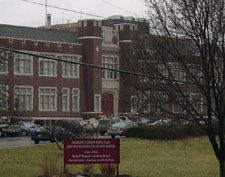 I visited the Hebrew Union College in Cincinnati, Ohio during a trip that I booked primarily for the purpose of viewing a temporary exhibit about the Frieder Brothers and their role in the rescue of European refugee Jews in The Philippines. In conjunction with this exhibit, the HUC hosted a memorial event, honoring the Frieder Family members, the Quezon Family members, and the family of Paul V. McNutt, as descendants of liberators who operated a rescue mission for refugees in Manila. I visited the Hebrew Union College in Cincinnati, Ohio during a trip that I booked primarily for the purpose of viewing a temporary exhibit about the Frieder Brothers and their role in the rescue of European refugee Jews in The Philippines. In conjunction with this exhibit, the HUC hosted a memorial event, honoring the Frieder Family members, the Quezon Family members, and the family of Paul V. McNutt, as descendants of liberators who operated a rescue mission for refugees in Manila.
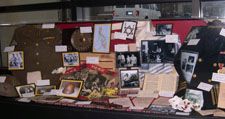 The Frieder Exhibit comprised 7 displays cases, set up in the foyer of the HUC JIR building, which were filled with material objects, photographs, and personal papers from the Frieder Family. This exhibit documented the extraordinary circumstances of this rescue event and is the first exhibit on this subject, that I am aware. The Frieder Exhibit comprised 7 displays cases, set up in the foyer of the HUC JIR building, which were filled with material objects, photographs, and personal papers from the Frieder Family. This exhibit documented the extraordinary circumstances of this rescue event and is the first exhibit on this subject, that I am aware.
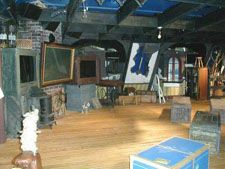 Unbeknownst to me until I arrived, the Center for Holocaust and Humanity Education at the HUC sponsored a permanent Holocaust exhibit titled "Mapping our Tears." It is an educational, interactive exhibit that focuses on the stories of local survivors and liberators from the Holocaust. In its mission statement, the Center deliberately decided to focus on the redeeming traits of humanity that emerged from Holocaust experiences rather than on the hate and savagery of the . . . Unbeknownst to me until I arrived, the Center for Holocaust and Humanity Education at the HUC sponsored a permanent Holocaust exhibit titled "Mapping our Tears." It is an educational, interactive exhibit that focuses on the stories of local survivors and liberators from the Holocaust. In its mission statement, the Center deliberately decided to focus on the redeeming traits of humanity that emerged from Holocaust experiences rather than on the hate and savagery of the . . .
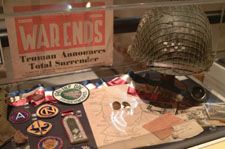 . . . perpetrators. For this reason, it is hard to find any kind of representation of the acts of Nazi persecutors or collaborators within the exhibit, feeling that such portrayals gave too much attention and unwitting validation to the atrocities. The exhibit serves to provide Holocaust education to local schools and visiting educators who struggle with the acceptable manner in which Holocaust memory should be projected to the future. . . . perpetrators. For this reason, it is hard to find any kind of representation of the acts of Nazi persecutors or collaborators within the exhibit, feeling that such portrayals gave too much attention and unwitting validation to the atrocities. The exhibit serves to provide Holocaust education to local schools and visiting educators who struggle with the acceptable manner in which Holocaust memory should be projected to the future.

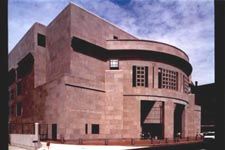 I first visited the USHMM in July 2004 and then visited it again in July 2006. Between these visits I explored the history of the planning and building of the museum and have compared its applied historical techniques with other museums in the US and throughout the world. The USHMM is considered by many in the field as the quintessential Holocaust Museum, rivaled only by the New Museum at Yad Vashem. I first visited the USHMM in July 2004 and then visited it again in July 2006. Between these visits I explored the history of the planning and building of the museum and have compared its applied historical techniques with other museums in the US and throughout the world. The USHMM is considered by many in the field as the quintessential Holocaust Museum, rivaled only by the New Museum at Yad Vashem.
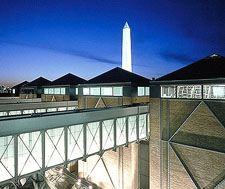 It is no mistake that the museum shares its site with the greatest iconographic structures in American society. Situated in the heart of Washington DC, across the street from the Washington Monument, its location projects the claim that America has a powerful place in Holocaust scholarship and that the Holocaust is as much a part of US history as any other time commemorated in the nation's capital. Using an artistic blend of both limestone and brick, its building materials seek to link it to both Israel and Europe. It is no mistake that the museum shares its site with the greatest iconographic structures in American society. Situated in the heart of Washington DC, across the street from the Washington Monument, its location projects the claim that America has a powerful place in Holocaust scholarship and that the Holocaust is as much a part of US history as any other time commemorated in the nation's capital. Using an artistic blend of both limestone and brick, its building materials seek to link it to both Israel and Europe.
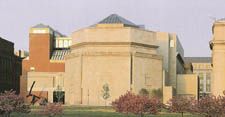 The limestone mimics the glistening white Jerusalem Stone that serves as the facade on all building construction in the State of Israel and the brick reminds us of the Ghetto Walls of Warsaw and the two story brick bunkers of Auschwitz. This use of building materials also links it esthetically to the buildings that flank it on either side. The limestone mimics the glistening white Jerusalem Stone that serves as the facade on all building construction in the State of Israel and the brick reminds us of the Ghetto Walls of Warsaw and the two story brick bunkers of Auschwitz. This use of building materials also links it esthetically to the buildings that flank it on either side.
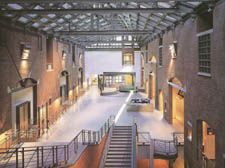 Upon entering the museum, visitors make their way to the Halls of Witnesses. Here designers have created a conclave of visual images from actual Holocaust sites, such as ghettos, camps, and places of transport, torture, and death. These visual presen-tations of the Holocaust only have immediate meaning for those visitors who have wit-nessed the sites personally. Elevators off to the side take visitors to the permanent exhibition. Upon entering the museum, visitors make their way to the Halls of Witnesses. Here designers have created a conclave of visual images from actual Holocaust sites, such as ghettos, camps, and places of transport, torture, and death. These visual presen-tations of the Holocaust only have immediate meaning for those visitors who have wit-nessed the sites personally. Elevators off to the side take visitors to the permanent exhibition.
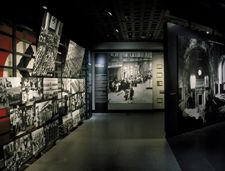 The Holocaust is the title of the museum's three-floor main exhibition. It presents a comprehensive history through the use of artifacts, photographs, films, and eyewitness testimonies, divided into three sections presented chronologically by floors. The visitors begin on the fourth floor with the Nazi Assault, 1933 - 1939. Here the national version of America's role in the Holocaust as liberator is the first concept of the exhibit seen by visitors. The Holocaust is the title of the museum's three-floor main exhibition. It presents a comprehensive history through the use of artifacts, photographs, films, and eyewitness testimonies, divided into three sections presented chronologically by floors. The visitors begin on the fourth floor with the Nazi Assault, 1933 - 1939. Here the national version of America's role in the Holocaust as liberator is the first concept of the exhibit seen by visitors.
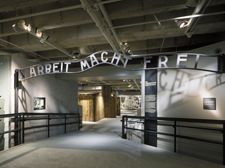 The third floor of the exhibit presents The Final Solution, 1940 - 1945. Showing many elements from the Auschwitz exhibits, I use this one subject area to talk about the methods of presentation used by the USHMM with comparisons of the same subject area in other museums. Here the USHMM museum designers made an actual cast of the Auschwitz front gate sign, "Arbeit Macht Frei," to "welcome" visitors into the horror of the death camp's experience. The third floor of the exhibit presents The Final Solution, 1940 - 1945. Showing many elements from the Auschwitz exhibits, I use this one subject area to talk about the methods of presentation used by the USHMM with comparisons of the same subject area in other museums. Here the USHMM museum designers made an actual cast of the Auschwitz front gate sign, "Arbeit Macht Frei," to "welcome" visitors into the horror of the death camp's experience.
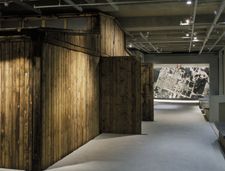 One of the most powerful methods of representation in the USHMM is its use of artifacts to re-create places of Holocaust memory. This is an actual reconstructed barracks from the Auschwitz II Birkenau concentration camp. It appears to burst its confines in its low ceiling display area, giving it an imposing presence. When using such artifacts with original photographs to contextualize the artifact in its actual setting, the result can have a powerful impact on visitors as they try to form a personal One of the most powerful methods of representation in the USHMM is its use of artifacts to re-create places of Holocaust memory. This is an actual reconstructed barracks from the Auschwitz II Birkenau concentration camp. It appears to burst its confines in its low ceiling display area, giving it an imposing presence. When using such artifacts with original photographs to contextualize the artifact in its actual setting, the result can have a powerful impact on visitors as they try to form a personal
connection to the place and event.
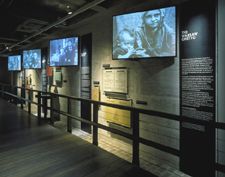 Not only does the USHMM utilize 900 artifacts throughout its exhibitions, but it employs 70 video monitors and 4 theaters to present historic film footage and eyewitness testimonies. The USHMM does a masterful job in using New Media applications to enhance the learning experience of its guests. It allows visitors to both read exhibits and to view documentation of the events in visual form at their own pace, moving through the exhibits as their own interests dictate. Not only does the USHMM utilize 900 artifacts throughout its exhibitions, but it employs 70 video monitors and 4 theaters to present historic film footage and eyewitness testimonies. The USHMM does a masterful job in using New Media applications to enhance the learning experience of its guests. It allows visitors to both read exhibits and to view documentation of the events in visual form at their own pace, moving through the exhibits as their own interests dictate.
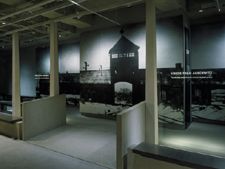 The theaters of the USHMM are quite different in their form and function. This Auschwitz Theater allows visitors to sit behind glass partitions, apart from the masses in the exhibit halls, and to hold and read printed testimonies while listening to the actual voices of the testifiers over a PA system. I believe this allows visitors a chance to sit and reflect on the horrifying images and disturbing facts just viewed, providing another opportunity for a personal connection to the facts. The theaters of the USHMM are quite different in their form and function. This Auschwitz Theater allows visitors to sit behind glass partitions, apart from the masses in the exhibit halls, and to hold and read printed testimonies while listening to the actual voices of the testifiers over a PA system. I believe this allows visitors a chance to sit and reflect on the horrifying images and disturbing facts just viewed, providing another opportunity for a personal connection to the facts.
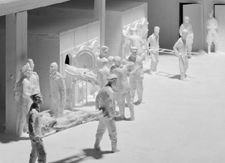 No other aspect of the Holocaust is as hard to fathom and to effectively portray than the mass exterminations executed at Auschwitz II Birkenau. Here is but one small scene from the massive pristine white model of the selection and execution processes at this death camp. This 3-D model portrays the entire process, from the arrival on the trains, to the selection process that split families forever, the undressing, the gas chambers, and the ovens. The model was sculpted by Mieczyslaw Stobierski based on contemporary documents and the trial testimonies of SS guards. This model is a recreation of the sculptor's model that has been on display in the State Museum of Auschwitz for many years. Another full model is in the museum at Yad Vashem as well. No other aspect of the Holocaust is as hard to fathom and to effectively portray than the mass exterminations executed at Auschwitz II Birkenau. Here is but one small scene from the massive pristine white model of the selection and execution processes at this death camp. This 3-D model portrays the entire process, from the arrival on the trains, to the selection process that split families forever, the undressing, the gas chambers, and the ovens. The model was sculpted by Mieczyslaw Stobierski based on contemporary documents and the trial testimonies of SS guards. This model is a recreation of the sculptor's model that has been on display in the State Museum of Auschwitz for many years. Another full model is in the museum at Yad Vashem as well.
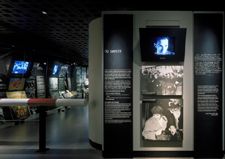 Any good museum lays out its exhibits so that its visitors can follow the intended pro-gression of the full exhibition, be it chrono-logically, as in the USHMM, or conceptually, as in the LA Museum of Tolerance. The USHMM provides for traffic flow through the logical stream of events, but yet still allows visitors the freedom to roam as they will, spending greater or lesser time at some exhibits over others. This is not always so at other museums I will discuss later. Any good museum lays out its exhibits so that its visitors can follow the intended pro-gression of the full exhibition, be it chrono-logically, as in the USHMM, or conceptually, as in the LA Museum of Tolerance. The USHMM provides for traffic flow through the logical stream of events, but yet still allows visitors the freedom to roam as they will, spending greater or lesser time at some exhibits over others. This is not always so at other museums I will discuss later.
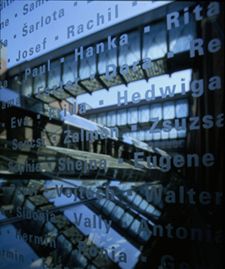 The walkways on the different floors that pass over the Hall of Witnesses, as visitors leave one exhibition area to enter another, have glass panel walls bearing names of cities and people lost to the Holocaust. Here is a glass panel with first names of victims who died as a result of the Nazi genocidal acts against the Jews. On the Second Floor of the permanent exhibit, visitors come into another theater, forum style with a large screen monitor, where guests can sit and watch Holocaust survivors give their own personal accounts of their Holocaust experiences. After having seen, heard, and touched the historical representation of the Holocaust for the past few hours, the impact of the survivor's testimonies is a powerful, emotional experience. The walkways on the different floors that pass over the Hall of Witnesses, as visitors leave one exhibition area to enter another, have glass panel walls bearing names of cities and people lost to the Holocaust. Here is a glass panel with first names of victims who died as a result of the Nazi genocidal acts against the Jews. On the Second Floor of the permanent exhibit, visitors come into another theater, forum style with a large screen monitor, where guests can sit and watch Holocaust survivors give their own personal accounts of their Holocaust experiences. After having seen, heard, and touched the historical representation of the Holocaust for the past few hours, the impact of the survivor's testimonies is a powerful, emotional experience.

 The NY Museum of Jewish Heritage's core exhibition is organized around three chronological themes, Jewish Life A Century Ago, The War Against the Jews, and Jewish Renewal, each told on a separate floor. The Museum prides itself in its memorial to the victims of the Holocaust by celebrating Jewish culture of the 20th century. The NY Museum of Jewish Heritage's core exhibition is organized around three chronological themes, Jewish Life A Century Ago, The War Against the Jews, and Jewish Renewal, each told on a separate floor. The Museum prides itself in its memorial to the victims of the Holocaust by celebrating Jewish culture of the 20th century.
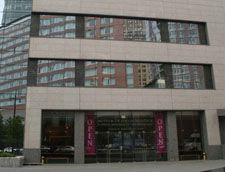 Through excellent exhibits on all aspects of Jewish life, its arts, literature, music, foods, religious piety, and family unity, the museum has depicted the lives and communities that shaped Jewish culture in the early part of the century so that museum guests can then truly comprehend the magnitude of its de-struction. Through gaining an understanding of Jewry before the Holocaust, it is felt that the generations after the Holocaust had a better sense of determination and courage to shape the renewal of Jewish life after the war. Through excellent exhibits on all aspects of Jewish life, its arts, literature, music, foods, religious piety, and family unity, the museum has depicted the lives and communities that shaped Jewish culture in the early part of the century so that museum guests can then truly comprehend the magnitude of its de-struction. Through gaining an understanding of Jewry before the Holocaust, it is felt that the generations after the Holocaust had a better sense of determination and courage to shape the renewal of Jewish life after the war.
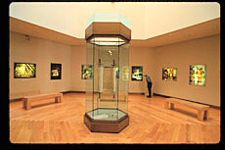 As a first time visitor, I was truly impressed with the presence of the Jewish heritage section of the museum. While other more renowned Holocaust Museums have some manner of display for representing Jewish life before the Holocaust, the NY Museum's portrayal was enriching and very comprehensive. The artifacts used and the manner in which they were were displayed made them emotionally accessible to visitors. I felt a greater loss of the human legacy, the human spirit, with this display of the Jewish past then I felt at the USHMM or at Yad Vashem. As a first time visitor, I was truly impressed with the presence of the Jewish heritage section of the museum. While other more renowned Holocaust Museums have some manner of display for representing Jewish life before the Holocaust, the NY Museum's portrayal was enriching and very comprehensive. The artifacts used and the manner in which they were were displayed made them emotionally accessible to visitors. I felt a greater loss of the human legacy, the human spirit, with this display of the Jewish past then I felt at the USHMM or at Yad Vashem.
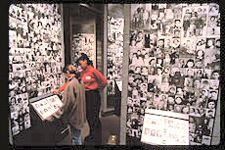 I believe that the museum's intent to elevate the visitor's appreciation for that which was lost is realized when the guest encounters NYC's Holocaust exhibit. Even though it is on a much smaller scale than the USHMM, there is nothing lacking in their historical information and emotional connection to their patrons. The NY Museum has also employed about 60 video monitors with testimonies of survivors augmenting the historical displays. I believe that the museum's intent to elevate the visitor's appreciation for that which was lost is realized when the guest encounters NYC's Holocaust exhibit. Even though it is on a much smaller scale than the USHMM, there is nothing lacking in their historical information and emotional connection to their patrons. The NY Museum has also employed about 60 video monitors with testimonies of survivors augmenting the historical displays.
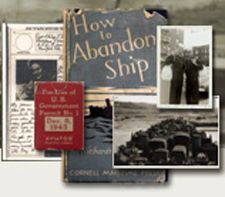 I was fortunate to have visited the NYC Museum when it was showing its Special Exhibit Ours to Fight For: American Jews During the Second World War. It was the inaugural exhibit in its new Robert M. Morgenthau Wing. I felt this exhibit was a perfect culmination to the overall experience of attending the NYC Living Memorial to the Holocaust. I believe the complete exhibition effectively preserves the particularistic nature of the Holocaust as a uniquely Jewish event, while still being mindful and respectful of Nazism's other millions of victims. I was fortunate to have visited the NYC Museum when it was showing its Special Exhibit Ours to Fight For: American Jews During the Second World War. It was the inaugural exhibit in its new Robert M. Morgenthau Wing. I felt this exhibit was a perfect culmination to the overall experience of attending the NYC Living Memorial to the Holocaust. I believe the complete exhibition effectively preserves the particularistic nature of the Holocaust as a uniquely Jewish event, while still being mindful and respectful of Nazism's other millions of victims.

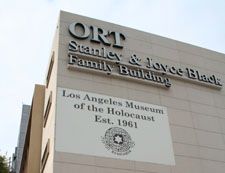 The Los Angeles Martyr's Memorial and Museum of the Holocaust was founded in 1961 by actual Holocaust Survivors and was the first museum of its kind in the United States. Since then, the Museum, which opened in 1978, claims a two-fold mission: to memorialize the victims of the Holocaust and to educate about this unprecedented period in World History. It is a small facility that maximizes its space in a very effective manner. Plans are in the works to build a newer, bigger, permanent facility. The Los Angeles Martyr's Memorial and Museum of the Holocaust was founded in 1961 by actual Holocaust Survivors and was the first museum of its kind in the United States. Since then, the Museum, which opened in 1978, claims a two-fold mission: to memorialize the victims of the Holocaust and to educate about this unprecedented period in World History. It is a small facility that maximizes its space in a very effective manner. Plans are in the works to build a newer, bigger, permanent facility.
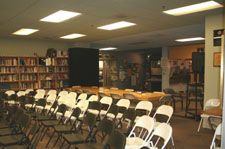 The central section of the museum is a multi-media reading room, with a modest library, and an ample amount of chairs seated in front of a lectern for guest speakers. Display rooms then feed off from this central area and house the historical exhibits. The guest book showed that attendance at the museum is quite low, but then several people who were there when I attended did not sign the register. The central section of the museum is a multi-media reading room, with a modest library, and an ample amount of chairs seated in front of a lectern for guest speakers. Display rooms then feed off from this central area and house the historical exhibits. The guest book showed that attendance at the museum is quite low, but then several people who were there when I attended did not sign the register.
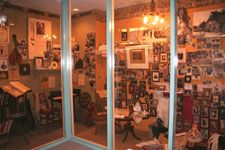 The first exhibit is The World That Was. This is a tightly packed exhibit of material items of Jewish cultural collected from Jewish communities of Europe. Items include dolls, china, porcelains, books, photographs, documents, journals, furniture, and other sundry items that would have been owned and used by typical Jewish families in the early 20th century. I applaud the museum's portrayal of Jewish life before the Holocaust. The first exhibit is The World That Was. This is a tightly packed exhibit of material items of Jewish cultural collected from Jewish communities of Europe. Items include dolls, china, porcelains, books, photographs, documents, journals, furniture, and other sundry items that would have been owned and used by typical Jewish families in the early 20th century. I applaud the museum's portrayal of Jewish life before the Holocaust.
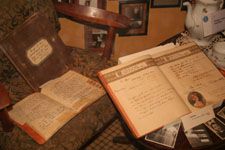 I would be interested in knowing how influential this early museum's chronological layout may have influenced museums of the United States that came later. The LA museum preserves the Jewish particularistic nature of the Holocaust through its reflective exhibit on Jewish life before the Holocaust. One suggestion would be to have had English translations of original documents that were exhibited in German, Yiddish, etc. I would be interested in knowing how influential this early museum's chronological layout may have influenced museums of the United States that came later. The LA museum preserves the Jewish particularistic nature of the Holocaust through its reflective exhibit on Jewish life before the Holocaust. One suggestion would be to have had English translations of original documents that were exhibited in German, Yiddish, etc.
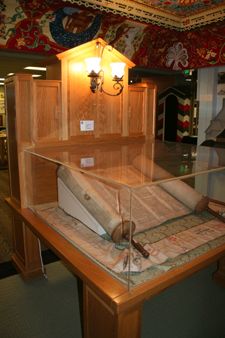 Adjacent to The World That Was Exhibit is the Torah Exhibit. Here on display is a rare Torah Scroll from The Czech Republic, circa 19th Century. It was hidden by a Jewish Polish family from the Nazis and brought to Israel. It was acquired by the Lodzer Foundation and donated in memory of the 1,500,000 Jewish children lost in the Holocaust. It is a rare opportunity for the public to see such an exquisite Jewish Torah up close and personal. I do not doubt that this is one of the museum's most precious artifacts. Adjacent to The World That Was Exhibit is the Torah Exhibit. Here on display is a rare Torah Scroll from The Czech Republic, circa 19th Century. It was hidden by a Jewish Polish family from the Nazis and brought to Israel. It was acquired by the Lodzer Foundation and donated in memory of the 1,500,000 Jewish children lost in the Holocaust. It is a rare opportunity for the public to see such an exquisite Jewish Torah up close and personal. I do not doubt that this is one of the museum's most precious artifacts.
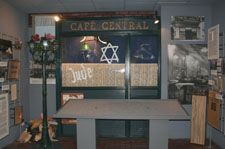 The next recessed exhibit room, titled Kristallnacht, portrays the rising antisemitism in Germany and its state sanctioned pogroms of the Nazi regime. DIfferent methods of presentaton are incorporated into one small space. On the floor in the left hand corner is a small bonfire depicting the burning of Jewish books. Shop windows are graffitied and broken, portraying the night of broken glass. The next recessed exhibit room, titled Kristallnacht, portrays the rising antisemitism in Germany and its state sanctioned pogroms of the Nazi regime. DIfferent methods of presentaton are incorporated into one small space. On the floor in the left hand corner is a small bonfire depicting the burning of Jewish books. Shop windows are graffitied and broken, portraying the night of broken glass.
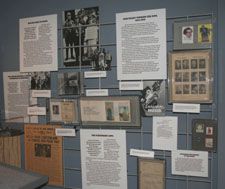 This exhibit wall of the Kristallnacht display is a typical layout for this museum. Historical write-ups, such as the Nazi Policies of 1933-1939, the Nuremberg Laws, Kristallnacht, etc., are arranged on a display panel with actual documents such as passports, letters, books, artifacts, newspapers, diaries, art, and photographs. After passing through most of the exhibits, I noticed that a deliberate choice was made not to aggrandize the iconography of the Nazi regime. I walked back through all the exhibits and the only displays of the actual . . . This exhibit wall of the Kristallnacht display is a typical layout for this museum. Historical write-ups, such as the Nazi Policies of 1933-1939, the Nuremberg Laws, Kristallnacht, etc., are arranged on a display panel with actual documents such as passports, letters, books, artifacts, newspapers, diaries, art, and photographs. After passing through most of the exhibits, I noticed that a deliberate choice was made not to aggrandize the iconography of the Nazi regime. I walked back through all the exhibits and the only displays of the actual . . .
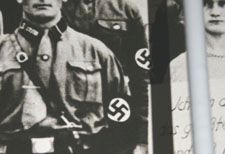 . . . Nazi swastikas were these armbands on German officers in a black and white photo that was downplayed and posted behind the display board and not on it. Except for the Holocaust Exhibit, Mapping Our Tears, at the HUC Center for Holocaust and Humanity Education in Cincinnati, the imagery of the infamous Nazi insignia is usually displayed in its blazing field of red and made bigger than life, presumably to impact the audience. . . . Nazi swastikas were these armbands on German officers in a black and white photo that was downplayed and posted behind the display board and not on it. Except for the Holocaust Exhibit, Mapping Our Tears, at the HUC Center for Holocaust and Humanity Education in Cincinnati, the imagery of the infamous Nazi insignia is usually displayed in its blazing field of red and made bigger than life, presumably to impact the audience.
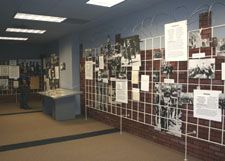 Museum visitors leave the central viewing and reading area and enter into aother exhibit area about The Ghettos. The background on the walls is painted to resemble the red brick of the Warsaw Ghetto Walls, with the barbed wire running across the top of the fence. It is an effective technique for a small area that cannot actually reconstruct a replica in its limited space. This room had original music compositions playing from Jewish artists portraying life in the ghetto through music. It provided a melancholy sound that heightened the atmosphere in this room. Seating areas along the back wall of the room allowed guests to sit and listen to the music, while reflecting on the picture before them that so graphically portray the horrors of life in the ghettos. Museum visitors leave the central viewing and reading area and enter into aother exhibit area about The Ghettos. The background on the walls is painted to resemble the red brick of the Warsaw Ghetto Walls, with the barbed wire running across the top of the fence. It is an effective technique for a small area that cannot actually reconstruct a replica in its limited space. This room had original music compositions playing from Jewish artists portraying life in the ghetto through music. It provided a melancholy sound that heightened the atmosphere in this room. Seating areas along the back wall of the room allowed guests to sit and listen to the music, while reflecting on the picture before them that so graphically portray the horrors of life in the ghettos.
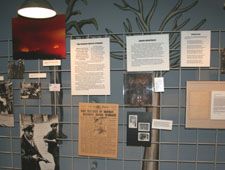 The next room, which runs parallel along the same axis as the Ghetto Exhibit room, is devoted to the topics of Resistance and the Ghetto Revolts. It is here that the first and only dramatic splash of color is seen - the color red, which draws our attention to the story of the Warsaw Ghetto Uprising. Most Holocaust exhibits are an artistic arrange-ment of black and white with other mellow hues. I have observed that red is the main color that is used to grab attention. The next room, which runs parallel along the same axis as the Ghetto Exhibit room, is devoted to the topics of Resistance and the Ghetto Revolts. It is here that the first and only dramatic splash of color is seen - the color red, which draws our attention to the story of the Warsaw Ghetto Uprising. Most Holocaust exhibits are an artistic arrange-ment of black and white with other mellow hues. I have observed that red is the main color that is used to grab attention.
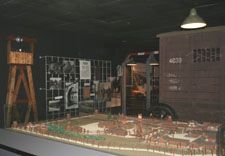 This next section of the museum, dedicated to Deportations and Camps, moved away from exhibit panel displays and presented reconstructed artifacts, such as a German train boxcar, sections of an electrical fence, a guard tower, entrance gates to a concentration camp, and bunks from the camp at Majdanek. Also in the area is a full scale model of the death camp of Sobibor, which was completely destroyed by the Nazis. This next section of the museum, dedicated to Deportations and Camps, moved away from exhibit panel displays and presented reconstructed artifacts, such as a German train boxcar, sections of an electrical fence, a guard tower, entrance gates to a concentration camp, and bunks from the camp at Majdanek. Also in the area is a full scale model of the death camp of Sobibor, which was completely destroyed by the Nazis.
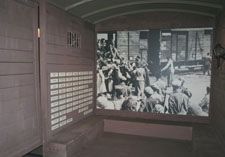 The boxcar replica is the actual size of the compartments that would be crammed with Jews being transported out of the ghettos to their awaited fate at one of the concentration camps, labor camps, or death camps. At either end of the interior of the car, which visitors must walk through to get to the other parts of the exhibit room, are large pictures taken by Nazi photographers of the deportations. The boxcar replica is the actual size of the compartments that would be crammed with Jews being transported out of the ghettos to their awaited fate at one of the concentration camps, labor camps, or death camps. At either end of the interior of the car, which visitors must walk through to get to the other parts of the exhibit room, are large pictures taken by Nazi photographers of the deportations.
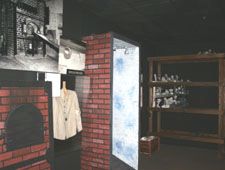 Some of the more "impressive" forms of display in Holocaust memorialization are representations of the gas chambers, the crematorium ovens, and the electrical fences (can be seen below). Large, well funded museums, such as the USHMM and the new Museum at Yad Vashem, have acquired actual parts of the real objects from different sites in Europe. Smaller museums with limited resources use other means to connect these subjects to their audience. Some of the more "impressive" forms of display in Holocaust memorialization are representations of the gas chambers, the crematorium ovens, and the electrical fences (can be seen below). Large, well funded museums, such as the USHMM and the new Museum at Yad Vashem, have acquired actual parts of the real objects from different sites in Europe. Smaller museums with limited resources use other means to connect these subjects to their audience.
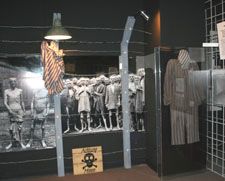 This area of the museum was very impressive and very well done. The displays were impactful and tastefully assembled. Overall, up to this point, I had nothing but praise and respect for the content of the exhibits and the manner of presentation in a facility with limited space and probably limited funds as well. Having myself been to Majdanek, Auschwitz, Birkenau, Belzec, and others, I readily recognized replicated items from all of these camps, and they were very well memorialized at this museum. However, . . This area of the museum was very impressive and very well done. The displays were impactful and tastefully assembled. Overall, up to this point, I had nothing but praise and respect for the content of the exhibits and the manner of presentation in a facility with limited space and probably limited funds as well. Having myself been to Majdanek, Auschwitz, Birkenau, Belzec, and others, I readily recognized replicated items from all of these camps, and they were very well memorialized at this museum. However, . .
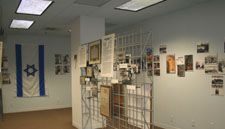 . . .the exhibit room on the Founding of Israel was a disappointment after the impressive exhibits in the Deportations and Camps section. This room was very amateurish, the pictures mounted on foam board, and labels glued onto construction paper. Walls were nearly blank and the historical information incomplete. I can only assume that it has yet to be finished. . . .the exhibit room on the Founding of Israel was a disappointment after the impressive exhibits in the Deportations and Camps section. This room was very amateurish, the pictures mounted on foam board, and labels glued onto construction paper. Walls were nearly blank and the historical information incomplete. I can only assume that it has yet to be finished.

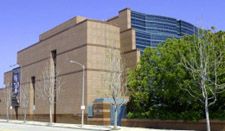 After spending the morning at the older, smaller and more traditional museum of the Holocaust on Wilshire Blvd, it was just an easy10 minute drivie to the monolithic Los Angeles Museum of Tolerance. I had heard slight criticisms of the museum in the past so I was expecting some unconventional methods of presentation but any other preconceptions I may have had ended there. My initial reactions to the Museum of Tolerance may undergo some massaging when I can make some return visits, but this museum is one of those venues that you either love or you really hate - there is very little room left for ambivalence. After spending the morning at the older, smaller and more traditional museum of the Holocaust on Wilshire Blvd, it was just an easy10 minute drivie to the monolithic Los Angeles Museum of Tolerance. I had heard slight criticisms of the museum in the past so I was expecting some unconventional methods of presentation but any other preconceptions I may have had ended there. My initial reactions to the Museum of Tolerance may undergo some massaging when I can make some return visits, but this museum is one of those venues that you either love or you really hate - there is very little room left for ambivalence.
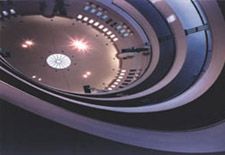 When arriving by car, you drive into massive underground parking and go up to the lobby by elevator. You exit the building in the reverse manner, never having opportunity to walk the grounds if there are indeed any to enjoy. Upon arrival at the lobby and after purchasing an entrance ticket and going through security, one's view of the museum's interior is that of another spiraling ramp-like passageway, this time for people rather than for cars. Seeing that we were just in time for attending a lecture by a Holocaust survivor, we took the interior elevator to the 2nd floor for the one hour event. After the lecture, we wandered around the upper floors of the facility completely alone. There were no docents or guides around inquiring if we needed assistance. When arriving by car, you drive into massive underground parking and go up to the lobby by elevator. You exit the building in the reverse manner, never having opportunity to walk the grounds if there are indeed any to enjoy. Upon arrival at the lobby and after purchasing an entrance ticket and going through security, one's view of the museum's interior is that of another spiraling ramp-like passageway, this time for people rather than for cars. Seeing that we were just in time for attending a lecture by a Holocaust survivor, we took the interior elevator to the 2nd floor for the one hour event. After the lecture, we wandered around the upper floors of the facility completely alone. There were no docents or guides around inquiring if we needed assistance.
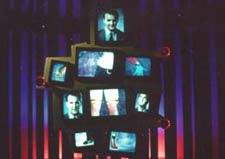 We finally made our way back down the ramp and entered the designated Holocaust Exhibit area. There was no docent to receive us - we were alone, no other guests, and we went through the entire facility without any guide or official interpretation by museum personnel. At the start there was this display of video monitors so we waited for some kind of media presentation to start. It was comical, flashy, loud, and informed us that . . . We finally made our way back down the ramp and entered the designated Holocaust Exhibit area. There was no docent to receive us - we were alone, no other guests, and we went through the entire facility without any guide or official interpretation by museum personnel. At the start there was this display of video monitors so we waited for some kind of media presentation to start. It was comical, flashy, loud, and informed us that . . .
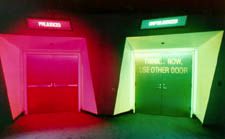 . . . we were all prejudiced, biased bigots and when directed to enter one of the neon-lighted doorways, we had no other choice but to enter through the "prejudiced" classification because the other "non-prejudiced" doors were permanently locked. We then entered into the "Tolerancenter," the preliminary exhibits that serve to contextualize the Holocaust into an inevitable generic world order of genocide. . . . we were all prejudiced, biased bigots and when directed to enter one of the neon-lighted doorways, we had no other choice but to enter through the "prejudiced" classification because the other "non-prejudiced" doors were permanently locked. We then entered into the "Tolerancenter," the preliminary exhibits that serve to contextualize the Holocaust into an inevitable generic world order of genocide.
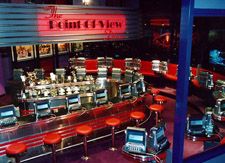 The Point of View Diner, which was an interactive media center, required some kind of initiation by museum staff and remained inactive during our visit. Prior to this exhibit, we viewed large screen media monitors with acts of world violence and terrorism, current day newspaper headlines of ongoing acts of political dissidence and revolt. These displays had the desired shock value effect of filling us with pain and horror, especially when we saw the plane hit the second tower of the World Trade Center on a large widescreen TV. My husband's cousin died instantly on that impact. I was disturbed that this image was used in such a glitzy, media-packed exhibit meant to overplay the drama of hate-filled violence in the world. The Point of View Diner, which was an interactive media center, required some kind of initiation by museum staff and remained inactive during our visit. Prior to this exhibit, we viewed large screen media monitors with acts of world violence and terrorism, current day newspaper headlines of ongoing acts of political dissidence and revolt. These displays had the desired shock value effect of filling us with pain and horror, especially when we saw the plane hit the second tower of the World Trade Center on a large widescreen TV. My husband's cousin died instantly on that impact. I was disturbed that this image was used in such a glitzy, media-packed exhibit meant to overplay the drama of hate-filled violence in the world.
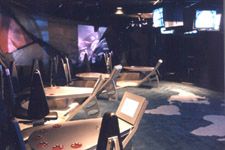 Another media center called The MIllennium Machine was yet another interactive station that required manual initiation. Being a bit annoyed with non-working technological wizardry, I looked around for some kind of power box, found a control panel on the wall and activated the exhibit myself, choosing a 15 minute film on refugees. Giant screens and a ceiling of video monitors sprung to life. This brings me to my objections to the whole content concept of the Museum of Tolerance that was embodied in this film - it would be better titled "The Museum of INtolerance" in that it presented mans inhumanity to man from the beginning of time to the most current events of our day without any clear message as to what was or should have been understood as "tolerance" in any of it. I think it did a great job of historically preserving a memory of global injustices instead. Another media center called The MIllennium Machine was yet another interactive station that required manual initiation. Being a bit annoyed with non-working technological wizardry, I looked around for some kind of power box, found a control panel on the wall and activated the exhibit myself, choosing a 15 minute film on refugees. Giant screens and a ceiling of video monitors sprung to life. This brings me to my objections to the whole content concept of the Museum of Tolerance that was embodied in this film - it would be better titled "The Museum of INtolerance" in that it presented mans inhumanity to man from the beginning of time to the most current events of our day without any clear message as to what was or should have been understood as "tolerance" in any of it. I think it did a great job of historically preserving a memory of global injustices instead.
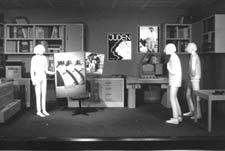 After going through the high media charged Tolerancenter, with many more "techno" exhibits on themes of bigotry and hate, we came to the understated beginning of their Holocaust exhibition. At the end of the preliminary stations, which included a timed video presentation on pre-war Jewry, we had to wait at electrically activated doors for a timer countdown before we could proceed into the main exhibit. After going through the high media charged Tolerancenter, with many more "techno" exhibits on themes of bigotry and hate, we came to the understated beginning of their Holocaust exhibition. At the end of the preliminary stations, which included a timed video presentation on pre-war Jewry, we had to wait at electrically activated doors for a timer countdown before we could proceed into the main exhibit.
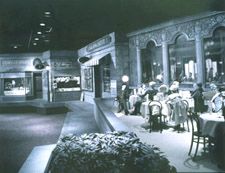 There was a series of lighted dioramas, some with doll-like characters who, when activated, discussed Holocaust themes in conver-sational form while recounting historical sequences and events. I found this manner of presentation to be stifling on several levels: first, it dictated the pace of the presentation and did not allow visitors to advance at their own discretion; second, the dialog was dramatized and put forward a certain biased interpretation of the history; and third, the information on the history of the Holocaust was far too generalized, leaving out important dates and sequences of events. I realize I was not experiencing it in the manner intended, since we had no guide with us, and perhaps on return visits I may come away with different observations. There was a series of lighted dioramas, some with doll-like characters who, when activated, discussed Holocaust themes in conver-sational form while recounting historical sequences and events. I found this manner of presentation to be stifling on several levels: first, it dictated the pace of the presentation and did not allow visitors to advance at their own discretion; second, the dialog was dramatized and put forward a certain biased interpretation of the history; and third, the information on the history of the Holocaust was far too generalized, leaving out important dates and sequences of events. I realize I was not experiencing it in the manner intended, since we had no guide with us, and perhaps on return visits I may come away with different observations.
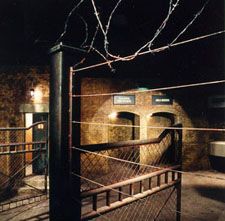 I can say that I was genuinely impressed with the physical representation of life and death in the ghettos and in the concentration camps. All things from the floors to the ceilings were re-created to give one the feeling of having entered into that world. But there were elements purposefully missing in this very modern media-packed museum that sent a deliberate message - the absence of reading material for the visitors. This exaggerated use of "TV Land" multimedia as its presentational method tells me that the museum curators believe that today's society of Americans do not read and . . . I can say that I was genuinely impressed with the physical representation of life and death in the ghettos and in the concentration camps. All things from the floors to the ceilings were re-created to give one the feeling of having entered into that world. But there were elements purposefully missing in this very modern media-packed museum that sent a deliberate message - the absence of reading material for the visitors. This exaggerated use of "TV Land" multimedia as its presentational method tells me that the museum curators believe that today's society of Americans do not read and . . .
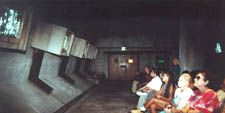 . . . are products of an age of television and entertainment and can only learn and be affected by a bombardment of their senses - which then becomes a self-fulfilling prophecy by not giving opportunity to experience and learn from more traditional forms of museum pedagogy along with the multi-media approaches. I think this narrow-minded method promotes over generalization of Holocaust scholarship that is detrimental to the preservation of Holocaust memory and the particularism of the Holocaust as a primarily Jewish event. After I have made another visit to the museum and I experience the exhibit in the manner it was intended, I will augment my observations if it is warranted. . . . are products of an age of television and entertainment and can only learn and be affected by a bombardment of their senses - which then becomes a self-fulfilling prophecy by not giving opportunity to experience and learn from more traditional forms of museum pedagogy along with the multi-media approaches. I think this narrow-minded method promotes over generalization of Holocaust scholarship that is detrimental to the preservation of Holocaust memory and the particularism of the Holocaust as a primarily Jewish event. After I have made another visit to the museum and I experience the exhibit in the manner it was intended, I will augment my observations if it is warranted.

Nearly two thirds of Europe's displaced Jews, all survivors of the Nazi inflicted genocide, sought a new life in Israel immediately after the war. The very existence of the newly formed Jewish State of Israel was itself a memorial to the victims. While some Holocaust historians have questioned the validity of America being a place of Holocaust commemoration, few if any have questioned Israel as an appropriate harbinger of Holocaust memory, even though it too lacks actual geographical sites of Holocaust commission. Like America, it can only devise recreations, realistic and/or abstract, to construct and project Holocaust memory.

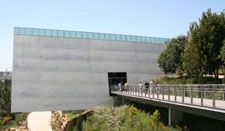 I never had the pleasure of viewing the Holocaust museum at Yad Vashem that predated their new museum. I can say that the New Holocaust History Museum at Yad Vashem has a very unique design. It is one very long, 180 meters, massive triangular concrete bunker that cuts across the entire hilltop, with both ends of the museum cantilevering over the precipes below. I never had the pleasure of viewing the Holocaust museum at Yad Vashem that predated their new museum. I can say that the New Holocaust History Museum at Yad Vashem has a very unique design. It is one very long, 180 meters, massive triangular concrete bunker that cuts across the entire hilltop, with both ends of the museum cantilevering over the precipes below.
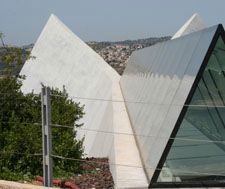 The picture above shows how visitors enter from the side. The top of the builiding is a series of windows, creating one long skylight that travels the entire length of the building, providing natural lighting to the interior of the museum, which is mostly underground. Pathways transect the top of the museum, allowing people on the paths to look down into the museum center.This view is from one of these pathways. The picture is looking towards the end of the museum that opens up skyward, giving museum goers a panoramic view of a scenic valley at the conclusion of their museum visit. This dramatic ending of the museum is meant to convey that the Land of Israel is the culmination of Holocaust history and that there is hope now for a better future for all Jews. The picture above shows how visitors enter from the side. The top of the builiding is a series of windows, creating one long skylight that travels the entire length of the building, providing natural lighting to the interior of the museum, which is mostly underground. Pathways transect the top of the museum, allowing people on the paths to look down into the museum center.This view is from one of these pathways. The picture is looking towards the end of the museum that opens up skyward, giving museum goers a panoramic view of a scenic valley at the conclusion of their museum visit. This dramatic ending of the museum is meant to convey that the Land of Israel is the culmination of Holocaust history and that there is hope now for a better future for all Jews.
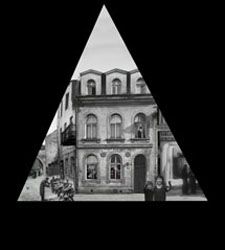 When visitors enter this museum, there is a triangular shaped video projection on the left wall that documents Jewish life in Europe before its destruction in the Holocaust. This video of scenes from Jewish towns and shtetls, now non-existent, can be seen from the main hallway of the museum as people criss-cross the hallway, moving from exhibit room to exhibit room. In this manner, Yad Vashem keeps the memory of the past continually running while visitors view the unfolding story of the Holocaust. The subject matter of the exhibits and the manner of their presentations, i.e., artifacts, clothing, documents, photographs, theaters, video monitors, testimonies, reconstructions, and replications resemble techniques used at the USHMM and the NYC Holocaust Museum. But make no mistake, the message of the New Museum at Yad Vashem is from a more Zionist point of view than the museums in the U.S. Jewish resistance and revolt and the formation of Israel are the heroic implications at Yad Vashem. When visitors enter this museum, there is a triangular shaped video projection on the left wall that documents Jewish life in Europe before its destruction in the Holocaust. This video of scenes from Jewish towns and shtetls, now non-existent, can be seen from the main hallway of the museum as people criss-cross the hallway, moving from exhibit room to exhibit room. In this manner, Yad Vashem keeps the memory of the past continually running while visitors view the unfolding story of the Holocaust. The subject matter of the exhibits and the manner of their presentations, i.e., artifacts, clothing, documents, photographs, theaters, video monitors, testimonies, reconstructions, and replications resemble techniques used at the USHMM and the NYC Holocaust Museum. But make no mistake, the message of the New Museum at Yad Vashem is from a more Zionist point of view than the museums in the U.S. Jewish resistance and revolt and the formation of Israel are the heroic implications at Yad Vashem.
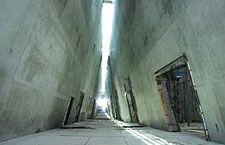 This view is taken from the beginning of the museum looking down the long straight hallway to the end of the museum. Exhibit rooms are to either side of the hallway. Circulation of the guests is controlled by roped off passages that transverse the hallway, going in and out of exhibits. In this manner, a visitor can only move as fast as the line in front of them moves. Some exhibits experienced "traffic jams" of people. This view is taken from the beginning of the museum looking down the long straight hallway to the end of the museum. Exhibit rooms are to either side of the hallway. Circulation of the guests is controlled by roped off passages that transverse the hallway, going in and out of exhibits. In this manner, a visitor can only move as fast as the line in front of them moves. Some exhibits experienced "traffic jams" of people.
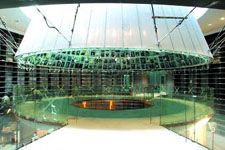 The Hall of Names is a unique component of the Museum of Holocaust History at Yad Vashem. Surrounding a circular center platform are rows and rows of archival boxes containing recorded and transcribed testimonies of survivors - a circular repository for the Pages of Testimony of Holocaust victims collected so far, with empty spaces for testimonies yet to be submitted—room for six million pages in total The Hall of Names is a unique component of the Museum of Holocaust History at Yad Vashem. Surrounding a circular center platform are rows and rows of archival boxes containing recorded and transcribed testimonies of survivors - a circular repository for the Pages of Testimony of Holocaust victims collected so far, with empty spaces for testimonies yet to be submitted—room for six million pages in total
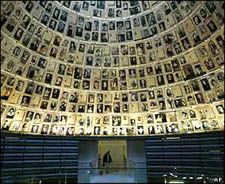 The Hall is composed of two cones: one extending ten meters skywards, echoed by a reciprocal well-like cone excavated into the natural underground rock, its base filled with water. Visitors enter the Hall in the circular space between the two cones onto an elevated ring-shaped platform. From here they can view the upper cone, where a display features 600 photographs of Shoah victims and fragments of Pages of Testimony reflected in the water at the bottom of the lower cone. The Hall is composed of two cones: one extending ten meters skywards, echoed by a reciprocal well-like cone excavated into the natural underground rock, its base filled with water. Visitors enter the Hall in the circular space between the two cones onto an elevated ring-shaped platform. From here they can view the upper cone, where a display features 600 photographs of Shoah victims and fragments of Pages of Testimony reflected in the water at the bottom of the lower cone.

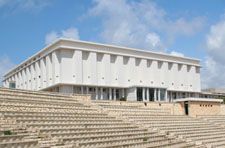 The Ghetto Fighters' House – Itzhak Katzenelson Holocaust and Jewish Resistance Heritage Museum was founded in 1949 by a community of Holocaust survivors, members of the Jewish underground in the ghettos of Poland, and veterans of partisan units, to be a place of testimony that would tell the story of the Jewish People in the 20th century in general, and during the Second World War in particular. At the center of this chronicle is the manifestation of Jewish resistance in its many forms. At the time of my visit, the museum was undergoing renovations so the exhibits have probably been modernized and improved since then. The Ghetto Fighters' House – Itzhak Katzenelson Holocaust and Jewish Resistance Heritage Museum was founded in 1949 by a community of Holocaust survivors, members of the Jewish underground in the ghettos of Poland, and veterans of partisan units, to be a place of testimony that would tell the story of the Jewish People in the 20th century in general, and during the Second World War in particular. At the center of this chronicle is the manifestation of Jewish resistance in its many forms. At the time of my visit, the museum was undergoing renovations so the exhibits have probably been modernized and improved since then.
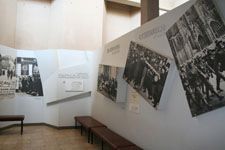 The main exhibit starts with a pictorial display of Nazi Germany Oppresses Countries and Nations. This exhibition presents a broad historical context in telling the story of the rise and establishment of the Nazi regime in Germany, and the process by which Germany extended its control over Europe prior to and during the Second World War. Visitors follow numbered displays that zigzag in the exhibit space. There are large spaces of blank walls that could be utilized for other manners of presentations. The museum employs no modern forms of multi-media, visual or aural. The main exhibit starts with a pictorial display of Nazi Germany Oppresses Countries and Nations. This exhibition presents a broad historical context in telling the story of the rise and establishment of the Nazi regime in Germany, and the process by which Germany extended its control over Europe prior to and during the Second World War. Visitors follow numbered displays that zigzag in the exhibit space. There are large spaces of blank walls that could be utilized for other manners of presentations. The museum employs no modern forms of multi-media, visual or aural.
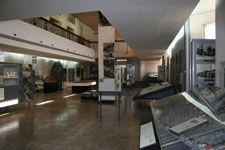 The Hall of the Ghettos is located directly following the exhibit: “Nazi Germany Oppresses Countries and Nations.” It deals with the ways in which Nazi Germany subjugated the Jews in Europe, the process that reached its peak with the Final Solution.This exhibit hall employs the use of scale models is depicting the lay out of certain ghettos, while also using free standing boards for exhibit displays. The Hall of the Ghettos is located directly following the exhibit: “Nazi Germany Oppresses Countries and Nations.” It deals with the ways in which Nazi Germany subjugated the Jews in Europe, the process that reached its peak with the Final Solution.This exhibit hall employs the use of scale models is depicting the lay out of certain ghettos, while also using free standing boards for exhibit displays.
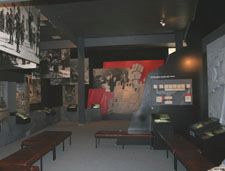 The Warsaw Ghetto FIghts Back is an exhibition devoted to the Jewish uprising in the Warsaw ghetto and is, to a great extent, the heart of the Ghetto Fighters’ House Museum. Its narrative unfolds on three levels: the story of Warsaw’s ghetto, the story of its armed uprising, and the personal story of Yitzhak Zuckerman and Zivia Lubetkin. Here is another example of the vivid use of red to emphasize the drama of the event. The Warsaw Ghetto FIghts Back is an exhibition devoted to the Jewish uprising in the Warsaw ghetto and is, to a great extent, the heart of the Ghetto Fighters’ House Museum. Its narrative unfolds on three levels: the story of Warsaw’s ghetto, the story of its armed uprising, and the personal story of Yitzhak Zuckerman and Zivia Lubetkin. Here is another example of the vivid use of red to emphasize the drama of the event.
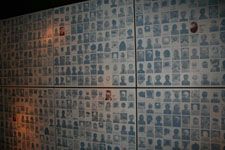 The Righteous Among the Nations exhibition is an homage to those non-Jews who risked their own lives to save Jews. Their stories are offered as individual testimonies. This display shows countless numbers of people with their backs turned to the viewers, while interspersed among their numbers is the occasional face front portrait, meant to show how few chose to be rescuers instead of collaborators or bystanders. Very effective! The Righteous Among the Nations exhibition is an homage to those non-Jews who risked their own lives to save Jews. Their stories are offered as individual testimonies. This display shows countless numbers of people with their backs turned to the viewers, while interspersed among their numbers is the occasional face front portrait, meant to show how few chose to be rescuers instead of collaborators or bystanders. Very effective!
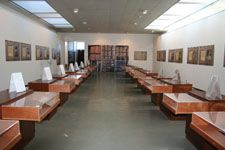 In The Realms of Memory exhibit is a conceptual and design realization that attempts to examine the significances of human memory and the human image. Behind the artifacts and documents that have been collected and preserved in the Archives of the Ghetto Fighters’ House, lie the compelling stories of individuals. These cases each represent an individual, their picture, their story, and a personal item from their past. This is the human element - the personal contact that visitors can have with the victims. In The Realms of Memory exhibit is a conceptual and design realization that attempts to examine the significances of human memory and the human image. Behind the artifacts and documents that have been collected and preserved in the Archives of the Ghetto Fighters’ House, lie the compelling stories of individuals. These cases each represent an individual, their picture, their story, and a personal item from their past. This is the human element - the personal contact that visitors can have with the victims.

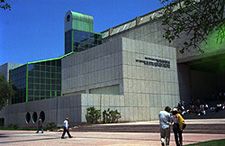 The Museum of the Jewish Diaspora is the first museum devoted to the history of the Jewish people and their contributions to human culture during more than two thousand years.The permanent exhibition at the Diaspora Museum tells the story of the Jewish nation in its dispersion, by means of drawings, video clips, movies, dioramas, and models. The permanent display concentrates on different subjects, among them "The Family Circle", "The Jews", "The Community", "Faith", "in the Family of the Nations" and "the Return to Zion". The Museum of the Jewish Diaspora is the first museum devoted to the history of the Jewish people and their contributions to human culture during more than two thousand years.The permanent exhibition at the Diaspora Museum tells the story of the Jewish nation in its dispersion, by means of drawings, video clips, movies, dioramas, and models. The permanent display concentrates on different subjects, among them "The Family Circle", "The Jews", "The Community", "Faith", "in the Family of the Nations" and "the Return to Zion".
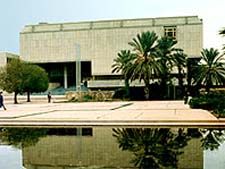 And while the mission intent of the museum is not to be a memorial to the Holocaust, certainly the events of the Holocaust are appropriately contextualized in the great span of global Jewish history. When viewing the entirety of Jewish history, through authentic reproductions of artifacts, art, literature, documents and other material items, the enormity of the loss because of the Holocaust is unspeakable. This is similar to the museum in NYC but on a grander scale. And while the mission intent of the museum is not to be a memorial to the Holocaust, certainly the events of the Holocaust are appropriately contextualized in the great span of global Jewish history. When viewing the entirety of Jewish history, through authentic reproductions of artifacts, art, literature, documents and other material items, the enormity of the loss because of the Holocaust is unspeakable. This is similar to the museum in NYC but on a grander scale.
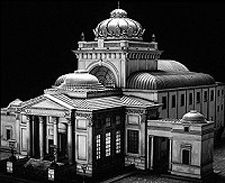 One of the more impressive exhibits was the area that housed 18 large authentic replicas of Jewish Synagogues throughout the world, past and present. It can certainly be considered a memorial to the Holocaust as guests are able to see both exterior and interior depictions of many of the great synagogues of Europe that were destroyed during the Kristallnacht pogrom or by advancing Nazi armies. This model of the Tlomackie Street Synagogue in Warsaw is the only means by which this synagogue can be appreciated by today's public. One of the more impressive exhibits was the area that housed 18 large authentic replicas of Jewish Synagogues throughout the world, past and present. It can certainly be considered a memorial to the Holocaust as guests are able to see both exterior and interior depictions of many of the great synagogues of Europe that were destroyed during the Kristallnacht pogrom or by advancing Nazi armies. This model of the Tlomackie Street Synagogue in Warsaw is the only means by which this synagogue can be appreciated by today's public.
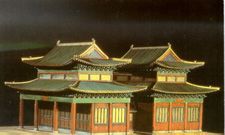 The Kaifeng Synagogue of China was another model that held great significance for me. The ancient Jewish Community of Kaifeng was the earliest known Jewish community of the Diaspora in the Far East, dating back to the 10th century. The pattern of acculturation of these ancient Jews appears to follow more recently applied theories of the "Port Jew Identity." Even though the capital city of Kaifeng was not a seaport, it was a major stop for merchants on the ancient trail of the Silk Road. This ancient dispersion of Jews abroad as a result of merchantilism is reflective in the more modern story of the settlement of Jews in The Philippines. The Kaifeng Synagogue of China was another model that held great significance for me. The ancient Jewish Community of Kaifeng was the earliest known Jewish community of the Diaspora in the Far East, dating back to the 10th century. The pattern of acculturation of these ancient Jews appears to follow more recently applied theories of the "Port Jew Identity." Even though the capital city of Kaifeng was not a seaport, it was a major stop for merchants on the ancient trail of the Silk Road. This ancient dispersion of Jews abroad as a result of merchantilism is reflective in the more modern story of the settlement of Jews in The Philippines.
Return to the top of page.
|